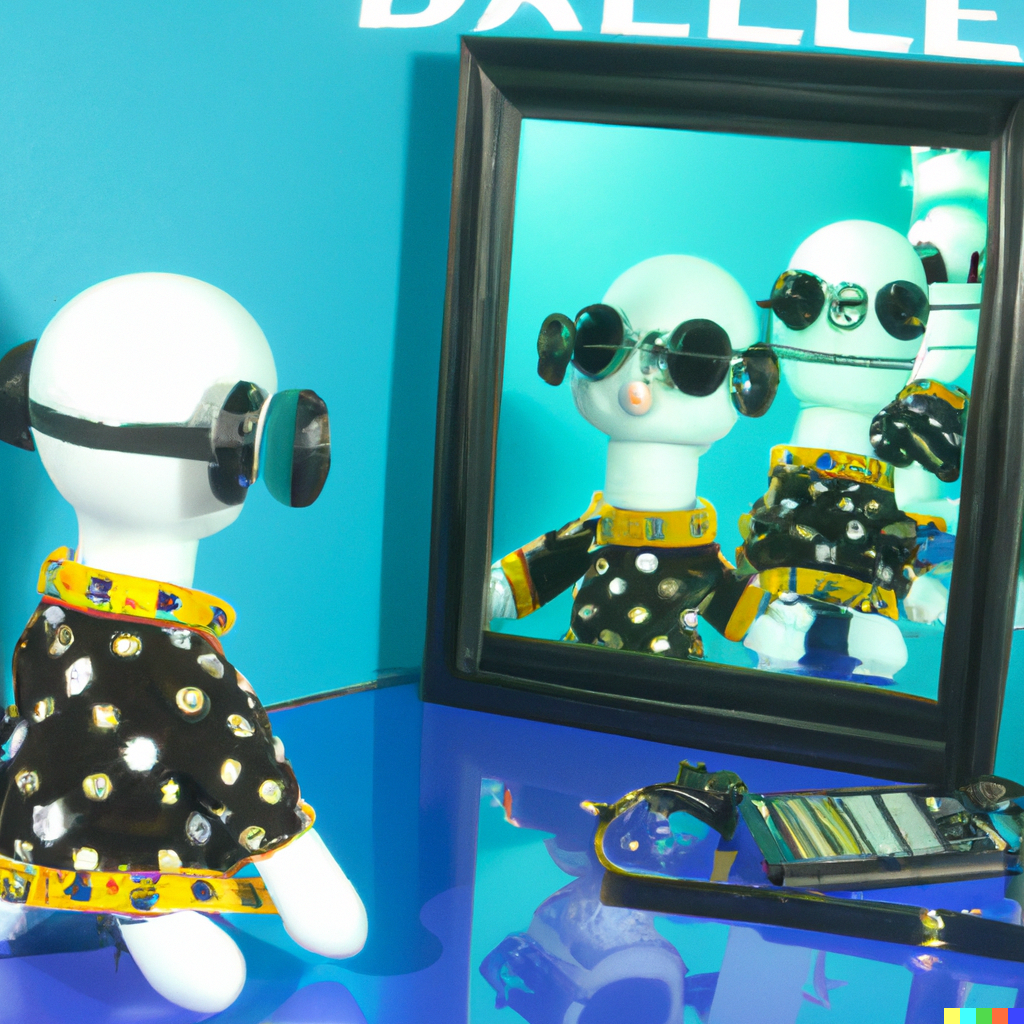I’m sorting out much of what I read of Gregory Bateson (1904-1980). And in his tradition, I’m going to make connections and then try to stand above it. Come and play. My entry point was Steps to an Ecology of Mind (1972), then I shot off into A Sacred Unity: Further Steps to an Ecology of Mind Edited by Rodney E Donaldson (1991) and then Nora Bateson’s Small Arcs of Larger Circles (2016). I’ve been thinking a lot about the question David Graeber and David Wengrow asked in The Dawn of Everything (2021): why do groups of people differentiate? Bateson’s observation of schismogenesis – a combination of the word schism and genesis – is “a process of interaction whereby directional[…]
Category: Design Thinking
You may have noticed a lot of sharing of Open AI’s Generative Pre-trained Transformer 3 (GPT-3) and ChatGPT screenshots. The most popular tend to be funny. I asked ChatGPT to describe in a style that Stephen King would write, a scene describing somebody struggling to decide which brand of toilet paper to buy. The result is fun. Here’s one about writing a script in Seinfeld style: In the sense that you can recognize the blend of styles. Elements of relevance and divergence are provided by the prompts. The evaluation, on the part of this author, is entirely subjective. And in some ways, carbon dated. Years from now, the bubble sort will be around. Probably. The knowledge of what a typical[…]
Von Hippel is onto something with the idea of need-solution pairs. This is how I understand the idea: Most management literature is focused on problem definition. (See: James G March for one of the best models of how problems drives search). Often, searches are sparked by a problem. But what if it isn’t always sparked by a problem? Von Hippel argues that search isn’t always motivated by formalized problems. Sometimes people are just discovering alternatives based on needs, and then, they compare a new alternative to the status quo. If the alternative is predicted to be better than the status quo, then the alternative will be substituted. If not, it’s rejected. This is a kind of a neat way to[…]
“I’m seeing things Believe me I’ve never seen before Little things Deceive me” Seeing Things, Theme Song, 1981 One common formula for a product vision comes from Steve Blank (2010, 2020). It goes like this: “For <customer segment> our product, <product name> is a <name the sector that customers say> that <benefit>. Unlike <competitors>, our product <discriminator>. Our product is <product name>.” And each bit of that formula can be systematically turned into a set of hypotheses that can be tested and refined until the vision is sufficiently true, or likely, to create a wonderful business if scaled. Blank himself repeats that entrepreneurs are rule breakers, so it’s really up to them which ones they want to break. Osterwalder and[…]
What if the rate of forgetting is interrelated with the rate of learning? What might that mean? The Knowledge Funnel The Knowledge Funnel is a model that describes how knowledge is made useful by an organization. At one side, you got mysteries. We live in an era where the number of mysteries vastly outnumbers the amount of knowledge. There is no shortage of mystery. Heuristics are rules of thumb that work most of the time, but not all of the time. There are lot of heuristics. They tend to form the core value driver for many organizations. There are comparatively fewer algorithms. Those organizations that have fit algorithms are often extraordinarily profitable and competitive. Some researchers focus on converting mysteries[…]
The Knowledge Funnel is a concept introduced by Roger Martin in Design of Business: Why Design Thinking is the Next Competitive Advantage (2009). The book is excellent and worth a read. There are mysteries at the top of the funnel. Mysteries are the unknown. They’re the known unknowns and the unknown unknowns. It’s knowledge that the organization doesn’t have. In the centre of the funnel, you have heuristics. These are rules of thumb. They aren’t quite always precise, and aren’t always quite reliable. Heuristics are just predictive enough to be useful. It’s knowledge that is known to the firm. At the bottom of the funnel you have algorithms. This is knowledge that is standardized and optimized enough to be run[…]
Imagine with me: what if novels were written like software. Sometimes it’s useful to approach absurdity and look inside. There might be treasure there. I’ll define software as an executable, a set of instructions, that are interpreted by a machine for some reason. As a data scientist, I think of software as a product, and I think, constantly, of turning data into product. I think of data as inertia and all the code around it as flexible. I worry a lot about the people that use the software (if anybody) and think of them as heterogenous segments. I think of a novel as an executable, a set of instructions, that are interpreted by a human brain for some reason. As[…]
Backcasting is a fantastic technique. It was invented in Canada. You’re welcome to use it. If it sounds like forecasting – well – that’s because it’s kind of like forecasting. With an important difference. That wikipedia page says: Whereas forecasting is predicting the future (unknown) values of the dependent variables based on known values of the independent variable, backcasting can be considered the prediction of the unknown values of the independent variables that might have existed to explain the known values of the dependent variable. I had to re-read it a few times to really get it. Once you get it, it’s just elegant. What’s beautiful is that it can silence the reactive-pure-statistician brain long enough for the prospective centre of the creative brain to imagine several futures. What I like about backcasting[…]
I was 28 and sleepless when I encountered a marketing version of the logistic function. It was beautiful. It’s one of those things you’re taught about in one context, and when you’re shown it from another angle, it expands your mind. It was like discovering Pi for the first time. I could use it to check the assumptions of a market penetration forecast, and substitute my own estimates for others. I felt empowered and delirious from being able to produce a solid forecast. It became a tool as useful as btau or the crosstab. There’s a part of that math, a variable called saturation, that worried me from the outset. Saturation is the maximum percentage of adoption that a market[…]
Bart Gajderowicz delivered a great talk at Machine Intelligence Toronto about how people go through stages in accomplishing a goal [1]. The talk was about homelessness and AI approaches to public policy. I instantly saw a connection to all sorts of tensions that people endure when they set out on a goal. To distill the concept, let’s start off with the idea that people have goals, people have emotions, and that time moves forward. As people make progress towards their goals, their emotions change over time. They start off in a good mood, in a state of uninformed optimism. Then, as negative information overwhelms their ignorance, they enter into a state of informed pessimism. So much negative information builds up[…]




